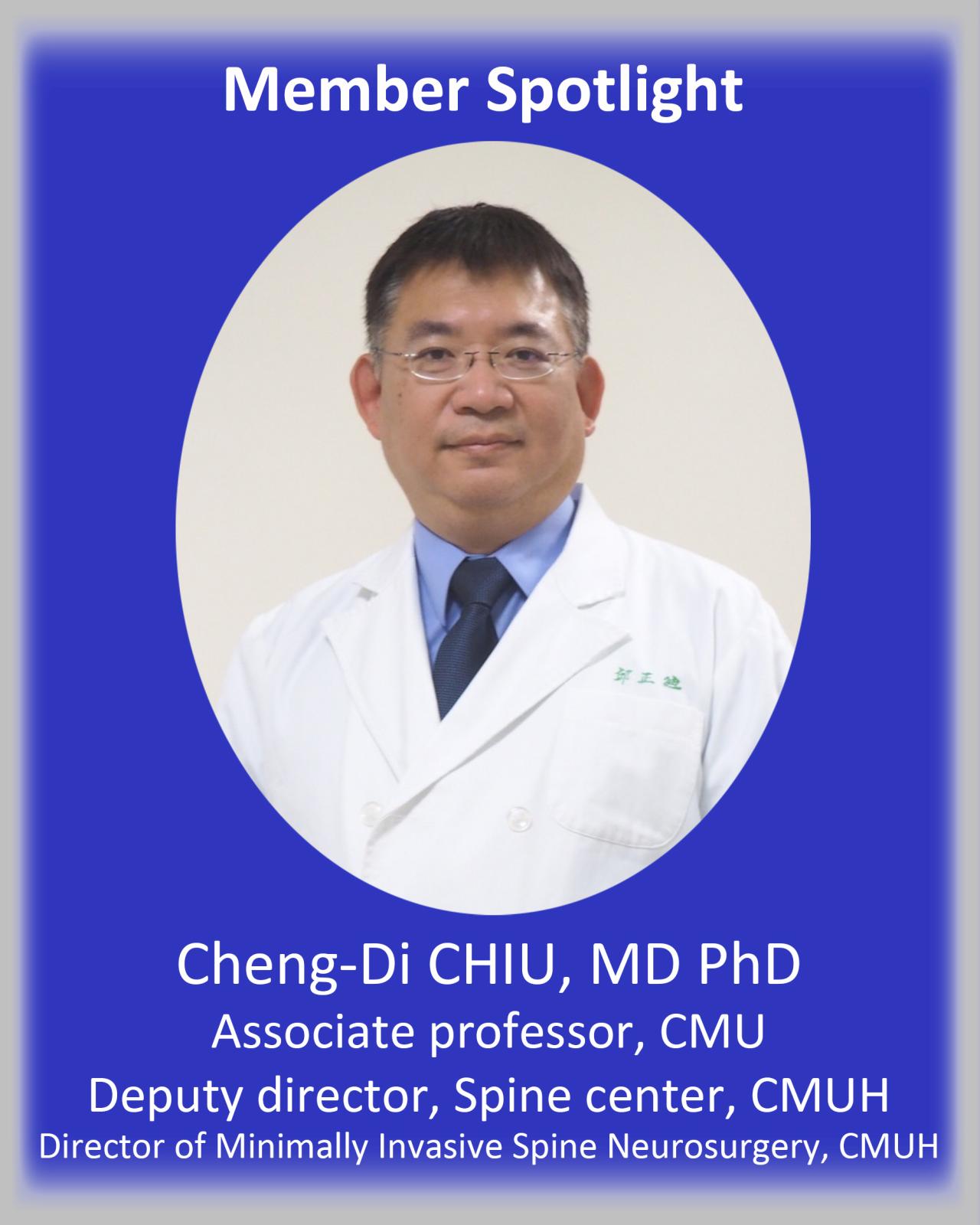Cheng-Di CHIU, MD PhD
Core Member
Associate Professor, School of medicine, China Medical University
Deputy director, Spine center, China Medical University Hospital
Director of Minimally Invasive Spine Neurosurgery, China Medical University Hospital
Education:
PhD, Institute of Medical Sciences, National Defense Medical College, National Defense University
MBA, Management college, National Taiwan University
MD, School of medicine, China Medical University
Research Expertise:
Stem cell research, Spine surgery, Neurology, Stroke
TEL : 04-22052121 ext.15036
副教授 | 邱正迪
核心成員
中國醫藥大學 醫學系 副教授
中國醫藥大學附設醫院 脊椎中心 副主任
中國醫藥大學附設醫院 微創脊椎神經外科 科主任
學歷:
中國醫藥大學 醫學系 醫學士
國防醫學院 醫學科學研究所臨床醫學組 博士
研究方向及專長:
幹細胞研究、脊椎手術、神經學、腦中風
聯絡電話: 04-22052121 ext.15036
Spinal Cord Injury (SCI) Research:
a. Developing a High-Precision Medical Imaging System to Predict the Prognosis of Cell Therapy for Spinal Cord Injury: We are currently developing a system using high-resolution 3D spinal structure imaging (3D T1 FLAIR CUBE) to monitor changes in spinal cord density and cross-sectional area. For functional MRI assessment, we are using Diffusion Tensor Imaging (DTI) to evaluate changes in water molecule diffusion characteristics in the spinal cord. In addition to the spinal cord, we are also using resting-state functional MRI and task-based functional MRI to analyze whole-brain connectivity, collectively assessing recovery after treatment.
b. Proteomics Analysis of Anti-inflammatory Factors in Mesenchymal Stem Cell Treatment for Human SCI: The limitations of systemic stem cell therapy administration and the time-consuming preparation process hinder its effectiveness in alleviating acute inflammation. Despite this, under the influence of the SCI environment, proteins secreted by MSCs still exhibit anti-inflammatory effects that aid SCI. We are using label-free proteomics to analyze the proteomic profiles of these two groups of samples. Analyzing the secretomes and prognoses of patients receiving MSC treatment will provide new insights into key proteins associated with the anti-inflammatory effects of MSCs.
c. Application of Integrin-Targeted Exosomes in the Treatment of Rat Spinal Cord Injury: Brain-derived neurotrophic factor (BDNF) is commonly used to assist in nerve repair, promote neurite outgrowth, or inhibit neuroinflammation. We have designed an engineered exosome containing BDNF mRNA and decorated with specific surface integrins on its lipid bilayer membrane, aiming to treat acute SCI.
d. Critical Care and Spinal Intraspinal Pressure Research: During the acute traumatic phase of SCI, besides undergoing surgery as soon as possible, steroid medications are the only treatment available to control the condition, aiming to reduce nerve damage caused by hypoxia due to intraspinal pressure. Although lumbar cerebrospinal fluid drainage can regulate spinal cord perfusion pressure based on intraspinal pressure, the limited number of cases makes it difficult to demonstrate the correlation between perfusion pressure control and motor function recovery in clinical trials. Therefore, we plan to use proteomics to analyze the secreted proteins in drained cerebrospinal fluid, identifying environmental factors in the acute spinal injury environment, with the ultimate goal of inventing new drugs to alleviate primary spinal injury.
Spinal Degeneration Research:
a. Clinical Performance Analysis of Patients Undergoing Interventional Treatment Surgery Using AI Algorithms to Analyze Surgery Success Rates.
b. Using the iHi Genomic Database of China Medical University Hospital to Analyze the Causes of Early-Onset Intervertebral Disc Degeneration.
Intracerebral Hemorrhage (ICH) Research:
The impact of astrocyte activation on the neural microenvironment of ICH remains unclear. We have found that acute astrocyte activation leads to an increase in the number of astrocytes near the hematoma, directly assisting in the clearance of heme iron. This is based on the high expression of haptoglobin in these activated astrocytes, enabling them to quickly uptake and degrade heme iron produced after hemolysis.
Research on Neurotrauma and Stroke Using National Health Insurance Database.

